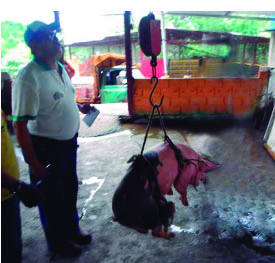Alternative feeding of growing and rearing pigs. Part I
Abstract
Sugar cane, Sacharum officinarum, originally comes from Asia, it is a perennial herbaceous plant, it adapts to tropical and subtropical climate conditions. It has a wide range of adaptation to altitude from sea level to 1,623 meters above sea level. It is the crop that produces the greatest amount of biomass in tropical conditions, from which the main product is juice, rich in soluble sugars, which can completely replace grains in concentrated foods.
References
Alcívar M., J, F. 2014. Utilización de dos niveles de harina de vísceras de pollos en remplazo de proteínas tradicionales en dietas en crecimiento y acabado de cerdos. Tesis de Grado. Escuela Superior Politécnica de Litoral. Guayaquil, Ecuador.
Donzele, J., J. Alveranga, J. Pereira, D. Lopes y D. Da Silva.1986a. Valor energético do caldo do cana de açúcar (Saccharum spp) para suinos na fase de terminação. Revista da Sociedade Brasileira de Zootecnia, 15:311-313.
Donzele, J., D. Lopes, J. Pereira, J. Alveranga y D. Da Silva, 986b. Valor energético do caldo do cana de açúcar (Saccharum spp) para suínos na fase de crecimiento. Revista da Sociedade Brasileira de Zootecnia, 15:307-310.
Gómez F. 1983. Caña de Azúcar. Editorial FONAIAP. Caracas, Venezuela. pp 400-650.
Ministerio del Poder Popular para Agricultura y Tierras. 2013. Departamento de estadística. San Cristóbal. Táchira.
National Research Council (NRC). 1981. Nutrient requirements of swine. Washington D.C., USA.
Okanovic, D., M Ristic, S. Kormanjos and S. Filipovic. 2009. Chemical characteristic of poultry slaughterhouse by-products. Biotechnology in Animal Husbandry, 25 (1-2). pp 143-152.
Pavarthy, K. 1983. Bottiling of sugarcane juice, proceedings of the schemes of studies on harvest & post harvest technology 8ICAR), Coimbatore Center, Annual Report, Feb. pp13-16.
Santana, R. y M Jiménez, 1985. Conservación de jugo de caña y comportamiento biológico de cerdos en crecimiento alimentados con jugo fresco y conservado. Tesis para optar por el título de Ingeniero Agrónomo. Universidad Central del Este, San Pedro de Macorís,
República Dominicana. 86 p.
Sarría, Patricia, A. Solano y T. R. Preston. 1990. Utilización de jugo de caña y cachaza panelera en la alimentación de cerdos. Livestock Research for Rural Development 2 (2).
Donzele, J., J. Alveranga, J. Pereira, D. Lopes y D. Da Silva.1986a. Valor energético do caldo do cana de açúcar (Saccharum spp) para suinos na fase de terminação. Revista da Sociedade Brasileira de Zootecnia, 15:311-313.
Donzele, J., D. Lopes, J. Pereira, J. Alveranga y D. Da Silva, 986b. Valor energético do caldo do cana de açúcar (Saccharum spp) para suínos na fase de crecimiento. Revista da Sociedade Brasileira de Zootecnia, 15:307-310.
Gómez F. 1983. Caña de Azúcar. Editorial FONAIAP. Caracas, Venezuela. pp 400-650.
Ministerio del Poder Popular para Agricultura y Tierras. 2013. Departamento de estadística. San Cristóbal. Táchira.
National Research Council (NRC). 1981. Nutrient requirements of swine. Washington D.C., USA.
Okanovic, D., M Ristic, S. Kormanjos and S. Filipovic. 2009. Chemical characteristic of poultry slaughterhouse by-products. Biotechnology in Animal Husbandry, 25 (1-2). pp 143-152.
Pavarthy, K. 1983. Bottiling of sugarcane juice, proceedings of the schemes of studies on harvest & post harvest technology 8ICAR), Coimbatore Center, Annual Report, Feb. pp13-16.
Santana, R. y M Jiménez, 1985. Conservación de jugo de caña y comportamiento biológico de cerdos en crecimiento alimentados con jugo fresco y conservado. Tesis para optar por el título de Ingeniero Agrónomo. Universidad Central del Este, San Pedro de Macorís,
República Dominicana. 86 p.
Sarría, Patricia, A. Solano y T. R. Preston. 1990. Utilización de jugo de caña y cachaza panelera en la alimentación de cerdos. Livestock Research for Rural Development 2 (2).

Published
2016-04-28
How to Cite
Ramírez, R., Fuenmayor, M., Semejal, R., Quintero, A., Cáceres, E., Celis, C., & Ramírez, F. (2016). Alternative feeding of growing and rearing pigs. Part I. INIA Divulga, 33(33), 56-59. Retrieved from http://publicaciones.inia.gob.ve/index.php/iniadivulga/article/view/790
Section
Artículos

